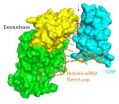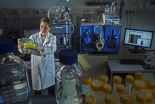(Press-News.org) (Embargoed) CHAPEL HILL, N.C. – Histone proteins are the proteins that package DNA into chromosomes. Every time the cell replicates its DNA it must make large amounts of newly made histones to organize DNA within the nucleus.
An imbalance in the production of DNA and histones is usually lethal for the cell, which is why the levels of the messenger RNA (mRNA) encoding the histone proteins must be tightly controlled to ensure the proper amounts of histones (not too many and not too few) are made.
In a collaborative effort published online in the January 18, 2013 issue of the journal Science, researchers at the University of North Carolina and Columbia University show for the first time how two key proteins in messenger RNA communicate via a molecular twist to help maintain the balance of histones to DNA.
"This is one of the safeguards that our cells have evolved and it is part of the normal progression through cell division – all growing cells have to use this all of the time," said study co-author William F. Marzluff, PhD, Kenan Distinguished Professor of biochemistry and biophysics at UNC's School of Medicine.
Every time a cell divides, Marzluff adds, it has to replicate both DNA and histone proteins and then package them together into chromosomes. "That way, each of the two cells resulting from division has one complete set of genes."
In humans, the 23 chromosomes that house roughly 35,000 genes are made up of both DNA and histone proteins. The DNA for a histone protein is first transcribed into RNA, which then acts as a guide for building a histone protein. Because the RNA relays a message – in this case a blueprint for a histone protein, it is referred to as messenger RNA, or mRNA.
Histone mRNAs differ from all other mRNAs and end in a stem-loop [or hairpin] sequence that is required for proper regulation of histone mRNAs. In this study, the Columbia team of Liang Tong, PhD, Professor of biological sciences and the corresponding author on this project, and graduate student Dazhi Tan used crystallography to reveal the structure of two important proteins near the end of the histone mRNA stem-loop. This molecular complex is required for regulating the levels of the histone mRNA.
One of these proteins, stem-loop binding protein (SLBP) is required for translation of histone mRNA into protein, and the other is an exonuclease, which is required to destroy the mRNA. Both were initially identified at UNC by Marzluff and colleague Zbigniew Dominski, PhD, Professor of biochemistry and biophysics, also a study co-author.
"We knew there was some interaction between SLBP and the exonuclease, so we asked Liang to explain how they bind and communicate," Dominski said. "And the surprising thing was that the proteins do it not by binding to each other but by changing the RNA structure at the site."
"From the science point of view, that was the most dramatic thing," Marzluff said. "The way these proteins help each other is either one can twist the RNA so the other can recognize it easier, and they don't have to touch each other to do that."
This protein complex is a critical regulator of histone synthesis, and is an important component of cell growth, he adds. "Interfering with it could provide a new method for interfering with cancer cell growth."
INFORMATION:
Funding for the research came from the National Institute of General Medical Sciences (NIGMS), a component of the National Institutes of Health.
Molecular twist helps regulate the cellular message to make histone proteins
2013-01-18
ELSE PRESS RELEASES FROM THIS DATE:
Inadequate food facilities in NC migrant camps could cause illness
2013-01-18
WINSTON-SALEM, N.C. – Jan. 17, 2013 – Farmworkers are at potential risk from food and waterborne illnesses because of the condition of cooking and eating facilities available to them, according to a new study from Wake Forest Baptist Medical Center.
Researchers from Wake Forest Baptist are the first to evaluate cooking and eating facilities in migrant farmworker camps to compare against established housing regulations. They found that the facilities fail to comply with regulations in a substantial number of camps. The study, which appears online today in the January issue ...
A global approach to monitoring biodiversity loss
2013-01-18
In contrast to climate change, there is no coordinated global system in place for measuring and reporting on biodiversity change or loss. An international team of biologists is now addressing this gap.
In Science today, 30 researchers led by Henrique Miguel Pereira, from the Centre for Environmental Biology of the University of Lisbon, proposed a global biodiversity monitoring system based on a set of essential variables.
By determining the most essential measurements to accurately and usefully report on biodiversity loss, known as essential biodiversity variables (EBVs), ...
Weight loss helps to oust worms
2013-01-18
Scientists from The University of Manchester have discovered that weight loss plays an important role in the body's response to fighting off intestinal worms.
The findings have been published in the journal PLOS Pathogens and show that the immune system hijacks the natural feeding pathways causing weight loss. This then drives the defense mechanisms down the correct pathway to expel the worms.
Nearly one quarter of the world's population is infected with gastrointestinal parasites. These prevalent infections often result in a period of reduced appetite resulting in ...
Sniffing immune cells
2013-01-18
This press release is available in German.
Immune cells constantly patrol our body to check for foreign invaders, such as bacteria or viruses. To do so they leave the blood stream, actively crawl through tissues and finally re-enter the circulation via lymphatic vessels. Research from the laboratory of Michael Sixt elucidates how the cells are guided through tissues like the skin. It is thought that cells either sense their environment by 'touching' or 'smelling': They adhere to structural molecules like connective tissue proteins using adhesion receptors. Or ...
Separating gases using a rigid polymer sieve
2013-01-18
Gas separation is crucial for many industrial processes including obtaining nitrogen or oxygen from air and purifying natural gas or hydrogen. Currently, the most energy efficient method for separating gases involves polymer membranes, however, most polymers either let gases pass through slowly (i.e. have low permeability) or are not selective towards one gas over another. Gas separation would be cheaper and use less energy if polymer membranes could be made both highly permeable and selective.
A team from the University's School of Chemistry reports in the journal Science ...
GI tract bacteria may protect against autoimmune disease
2013-01-18
This press release is available in German.
Toronto -- Early life exposure to normal bacteria of the GI tract (gut microbes) protects against autoimmune disease in mice, according to research published on-line in the January 17 edition of Science. The study may also have uncovered reasons why females are at greater risk of autoimmune diseases such as multiple sclerosis, rheumatoid arthritis, and lupus compared to males.
Researchers from The Hospital for Sick Children (SickKids) found that when female mice at high risk of autoimmune (type 1) diabetes were exposed ...
U Alberta researchers move Barkhausen Effect forward
2013-01-18
(Edmonton) Almost 100 years after the initial discovery, a team of scientists at the University of Alberta and the National Institute for Nanotechnology in Edmonton have harnessed the Barkhausen Effect as a new kind of high-resolution microscopy for the insides of magnetic materials.
The researchers say the technique has the potential to provide critical information as a rapid prototyper for magnetic computational devices that expand the role of magnetism within computers.
In 1919, Barkhausen discovered the first evidence of magnetic domains (patterns in how the directions ...
Doubling down on energy efficiency
2013-01-18
Spending on energy efficiency programs funded by electric and natural gas utility customers will double by 2025 to about $9.5 billion per year, according to projections published today by researchers at Lawrence Berkeley National Laboratory (Berkeley Lab).
These funds, which come from a charge on utility bills, historically constitute the nation's largest source of spending on programs to foster the adoption of more efficient products and buildings. According to the Berkeley Lab report, energy efficiency programs funded by utility customers are projected to continue ...
Novel sensor provides bigger picture
2013-01-18
DURHAM, N.C. – Duke University engineers have developed a novel sensor that is more efficient, versatile and cheaper for potential use in such applications as airport security scanners and collision avoidance systems for aircraft, cars or maritime vessels.
The researchers fabricated a unique material, known as a metamaterial, that acts as a lens to image scenes using fewer components than conventional detectors. Because of the properties of this man-made material, much of the additional equipment needed for conventional detector systems – like lenses, mechanical positioners ...
Irregular heart beat elevates risk of kidney failure
2013-01-18
Many people who suffer from chronic kidney disease progressively lose their kidney function over time and eventually develop a condition called end-stage renal disease – the complete failure of the kidneys – placing them in need of lifelong dialysis or a kidney transplant.
Now researchers at the University of California, San Francisco (UCSF) and the Kaiser Permanente Northern California Division of Research have found that the risk of kidney failure is greater for people with chronic kidney disease who also have atrial fibrillation, one of the most common forms of irregular ...





